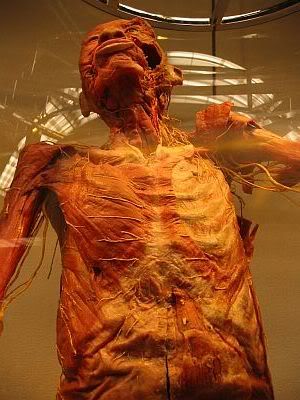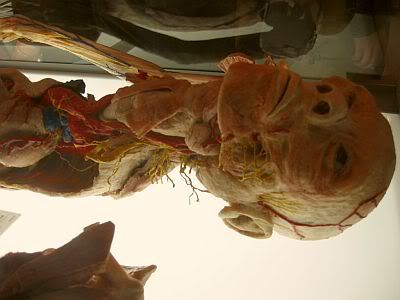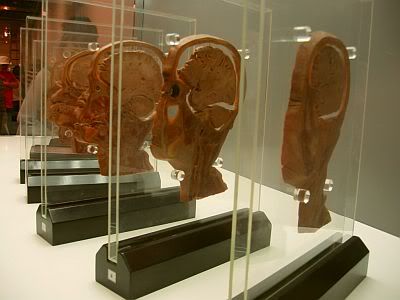Did you know that an ostrich's brain is smaller than its eye? Do you know the size of the human brain ? How heavy is an adult human brain ? You can't always tell how big someone's brain is from the size of their head. And larger brains do not necessarily imply higher intelligence. This means that someone with a larger brain may be less intelligent than someone with a smaller brain. However, larger brains do correlate with higher intelligence. Did you know that the large intestine is about 5 feet long but the small intestine can be as long as 23 feet depending on the size of the human body ? Do you know when the fetus begin to assume the human form - the development of the fetus through its various stages ?

The human body is the most wonderful and complex machine in the world. A visit to the Mysteries of the Human Body Exhibition allowed me to have a closer look inside the human body - an anatomic display of plastinated real human specimens, including whole bodies as well as individual organs and body slices.
Date : 2nd April 2005 - 22nd May 2005
Venue : The Museum of Kyoto, Japan
Entrance Fee : 1400 yen

Attached here were a few of the many specimens. Almost half the body's weight is muscle. The heart has a claim to being the muscle that performs the largest quantity of physical work in the course of a lifetime. Skeleton is a collection of bones that holds the rest of our body up. The skeleton changes composition over a lifespan. When you were born, your skeleton had around 350 bones. By the time you become an adult, you will only have around 206 bones (the numbers can vary slightly from individual to individual).

A typical person has around 4 - 5 litres of blood. All of us know that human blood is red. Blood is never blue, but veins appear blue because light is diffused by skin (look at the veins of your wrist).

This is the most interesting part of the exhibition. Here the head was seen sectioned at 1 - 2 centimetre intervals. The head was frozen in a special material to preserve the tissues and organs. And sagittal sections (Y-Z plane) follow from one side of the head to the other. The nervous system is the most complex and delicate of all the body systems. At the centre of the nervous system is the brain. The brain, along with the heart, is one of the two most important organs in the human body. Loss of function in this organ fufills some definitions of death. In the exhibition, one can also view the whole human body sectioned into three different planes. The transverse sections (X-Y plane) slicing the body from top to bottom (head to feet).
There are much to see and, it is definitely worth a visit to this exhibition (during weekdays to avoid the crowds) despite high entrance price.

According to Buddhism, birth as human is truly rare. Birth need not be considered particularly joyful, nor a great danger. Likewise death need not be sad. Everything depends on attitude. There is actually very little needed to make a happy life. The universe changes, our life is what our thoughts make it. Create a healthy lifestyle that you deserve - maintain a healthy mind and body.

15 comments:
Hello Patrick,
Nothing is scary to e pics la..human must know anyway, theoritically, you've better description on each of the pics provided..but i have some queries against and wanted to leave a comment..it's 2am in the morning..gotta hit the sack to sleep..brb!! brb!! night..Good nite patrick.
charlene out.
I love what you are doing with your blog. Keep it up it's great.
Not scary...but indeed very interesting. By the way, when you mention the head was sectioned at 1 - 2 centimetre intervals, are they real?? I couldn't imagine doing that to a real human being cause it is so gross.
Thanks for your message in my post. I don't think my pix are qualified enough to be published.
All the picture look so scary, but i do enjoy reading it. But i think you must be feeling really burgh while visiting this place.
charlene : waiting for questions but maybe i wont be able to answer difficult questions. how was your day ? i went for aoi festival today. made some new friends. took nap and good dinner. it was great weekend.
odd : thanks for comment. will keep updating whenever i have time to write and pictures. now i still have about 100 pictures that i want to share. so keep coming back. ok ?
emotionalistic : yes. it is real. like slab of ham. disgusting. the best part was section from head to feet to somewhat twenty thirty slices.
eaow : your pictures are good enough. your skills are definitely better than mine. give it a try : it is good to see our pictures published in the newspaper (although there will be no prize). you know what : one of my taiwanese friend is requesting my pictures for publish in one article in taiwan. oh i feel good.
mrkiasu : it was quite eerie and disgusting inside the exhibition hall. there is one real human specimen which we are allowed to touch - like hard plastic because of the preservation chemicals. after seeing that place... i had barbecue at night. still good appetite. (:P)
Hello Patrick..i had a decent enjoyable weekend (thank you)! and am glad you r making a lot of wonderful friends..keep it up!
The following merely stating my queries:-
Do you meant & with e Bones narrated in such that each person has about 206 bones, though some ppl have more and some ppl less? But then, how many bones for a human skull, as far as i understand that the skull protects our brain, the rib cage protects our heart and the backbone protects our spinal cord..*curiousity aroused*. Does the exhibition specifically describe this? Also, How many bones for our backbone or vertebral column and how many bones that conduct human sound waves in both of our ears? Have u ever think of this?..
Hmm patrick, u know what, after reading ur post, now that i know the complexity of the brain, not its size, accounts for its capacity. Dolphins, and elephants have larger brains, though in proportion to our body size, ours is the largest! The question is, among humans, it appears that brain size doesn't effect intelligence, i am beginning to think does Einstein's brain larger than anyone else's, i meant after his death..does the exhibition you've attended also mentioning bout this? Or have you ever think of my queries..hmmm…looks like Charlene asking all sorts of rambling..but I don’t know.
Addendum: I love your quote of the day: -
"Everything depends on attitude. There is actually very little needed to make a happy life. The universe changes, our life is what our thoughts make it. Create a healthy lifestyle that you deserve - maintain a healthy mind and body." (I would said: Life is like a box of chocolates, u don't know what u may find, be grateful on what you have :) )
Cheers Patrick!:), eh, nothing is scary la e pics..lol! g'nite!
charlene out.
I hope you found wht you needed at flickr. I went to the same exhibition as you did but I did not realised that you can take pictures in the museum! Ah....the wasted opportunity. I found the exhibition damn interesting, particularly since I study human osteology (bones), so it is interesting to see how muscles, tissues etc corelates with the bones in the human body. Though there was one exhibit that was kind of disturbing, the one of the fetus to the full 9 months.
charlene : Generally there are 206 bones in your body (axial skeleton 80 bones and appendicular skeleton 126 bones). The number of bones varies slightly due to the variation in the number of sesamoid bones in the hands and feet. The skull is composed of 29 different bones. One of the main functions of the skeleton is to protect the internal organs. The vertebral column contains 32 bones and there are three bones in the middle ear. Like you have mentioned, these three bones act in series to transmit airborne sound through the middle ear to the inner ear. Once the sound (or vibration) reaches the cochlea, it is converted into nerve impulses and transmitted to the brain.
Animals differ in intelligence, and humans are usually considered to be by far the most intelligent. Intelligence may be defined and measured by the speed and success of how animals, including humans, solve problems to survive in their natural and social environments. Primates, elephants and cetaceans (marine mammals) are assumed to be more intelligent than 'lower' mammals, the great apes and humans more than monkeys, and humans more than the great apes. Brain properties which assumed to be relevant for intelligence are the relative size of the brain (not conclusive although among large mammals, humans have the relatively largest brain), cortex, prefrontal cortex and degree of encephalization (changes in brain size during evolution - during million years of human evolution, an enormous increase in brain size has occured). However, other factors that can correlate better with intelligence are the number of cortical neurons and conduction velocity, as the basis for information-processing capacity (the intrinsic organization and complexity of the brain). There are also other a combination of other factors, for more information refer to : Roth, G. and Dicke, U. (2005) Evolution of the brain and intelligence. Trends in Cogn. Sci. 9, 250 - 257.
phew. tough questions.
ailing : yes, fetus and baby development specimens were indeed disturbing but for science and knowledge, it is good exposure.
charlene : there are too many people in the exhibition to enable us to really read information for each exhibit. but on the other hand, i cannot read japanese language. so i mostly just looked at the specimens or asked a friend or a nearby doctor for extra information when curiosity aroused.
Good afternoon Patrick
I am pleased to say thank you for your awesome explanation of my tough questions! sorry if its taking u a long time to get to answer my questions..now that i've documented your explanation into my notebook, created a folder though..i've better understanding on human brain..think we should know more...Thanks again patrick..A lovely day ahead of you!!
charlene.
Dear Patrick and Charlene,
Variations of the number of human bones can also occur in the vertebrae and the ribs.
The vertebral collumn usually consists of 33 segments (varies), the 24 upper movable vertebrae, the sacral vertebrae(5 which fuses to form the sacrum) and the coccyx (usually 4 fused segments).
There are usually 28 bones in the skull, 22 bones plus the 6 ear bones. The 29th bone is the hyoid, which is usually not considered part of the skull but it is often grouped with it. The most interesting fact about this bone is that it is the only bone in the body that does not articulate with another bone and is suspended by ligaments. It supports the tongue and gives attachments to muscles used in speech.
Note that the word "usually" is often used while describing the number of bones.
Thought you might like the further information! It was good fun for me too, to dig back into all my books...it helped me to reconfirmed my facts...might have forgotten some of them already! For further reading, if you are interested, read Human Osteology by William M Bass and Human Osteology by Tim D White. Be warned though, they are heavy books to read...osteology textbooks. Both could be found in the library. They are my bibles for my studies here! Hahaha
ai ling : thanks for information :) i have earlier thought to ask you to help me with charlene's question, but great that you cleared our doubts (yes 2 ears 3x2=6 ear bones :P). and regarding pictures, no cameras are not allowed inside the exhibition hall. i only knew after i took some pictures. i decided not to delete them and took the risk to publish in the blog. i hope it is ok. but we learnt about the human body, didnt we ? thanks again.
hello patrick
Looks like i am feeling accomplished today..got a perfect answer from your goodself..hehe..another good news was i got a called from BAT..2nd interview next week..and i also got another job offered from another potential company..hehehe..the day is bright! and wish you too!
charlene.:)
Phew! The comments itself were a tough read. Like attending some science class. :) *clap, clap, clap* Patrick, you're good. Are you a lecturer at uni or something? Ahaks!
Post a Comment